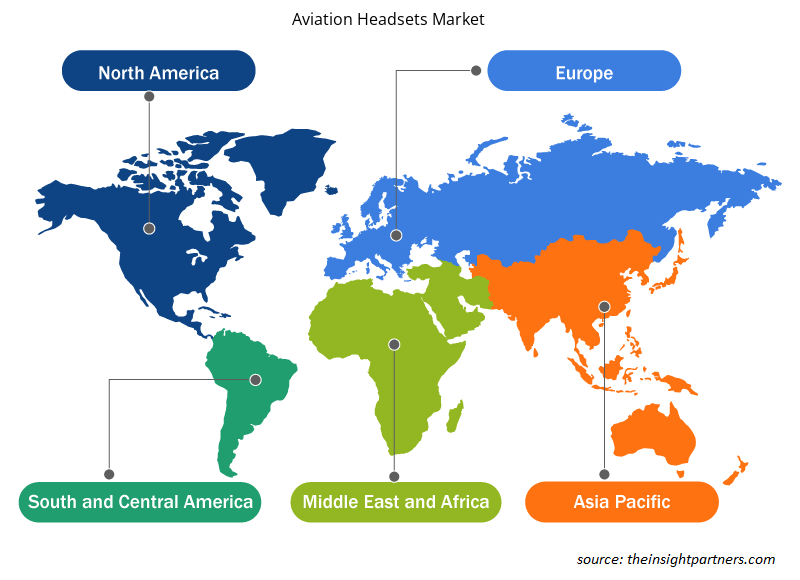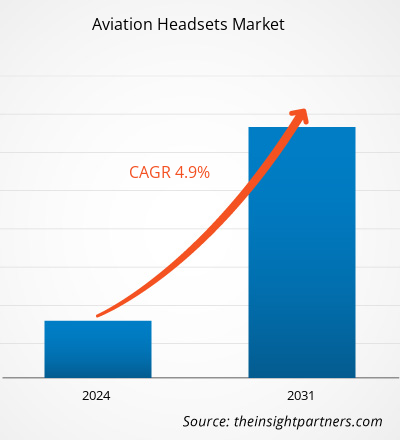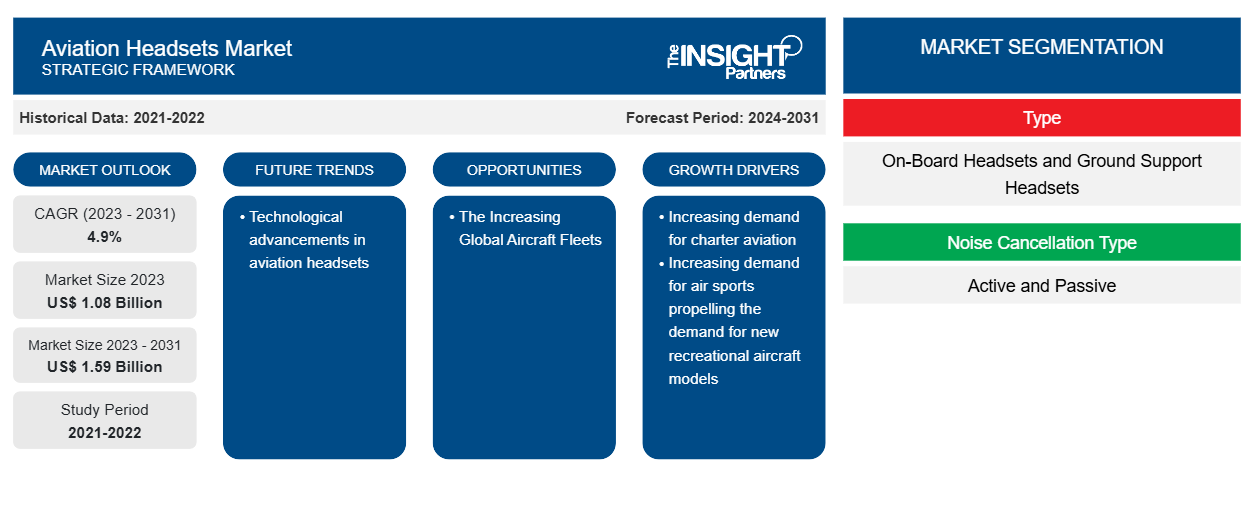Si prevede che il mercato delle cuffie per l'aviazione raggiungerà 1,59 miliardi di dollari entro il 2031, passando da 1,08 miliardi di dollari nel 2023. Si prevede che il mercato registrerà un CAGR del 4,9% nel periodo 2023-2031. È probabile che i progressi tecnologici nelle cuffie per l'aviazione rimangano una tendenza chiave nel mercato.
Analisi del mercato delle cuffie aeronautiche
L'ecosistema del mercato delle cuffie per l'aviazione è diversificato e in continua evoluzione. I suoi stakeholder sono fornitori di componenti, produttori di cuffie, distributori e utenti finali. I principali attori occupano posizioni nei vari nodi dell'ecosistema di mercato. I fornitori di componenti forniscono diversi componenti come prodotti semiconduttori/chipset, microfoni, componenti per altoparlanti ai produttori di cuffie per l'aviazione che poi li utilizzano per produrre e progettare i prodotti finali per cuffie per l'aviazione. Il prodotto finale viene poi distribuito agli utenti finali tramite diversi mezzi come le vendite dirette tramite distributori aziendali nel settore dell'aviazione.
Panoramica del mercato delle cuffie aeronautiche
Aziende come Bosch Security & Safety Systems, Bose Corporation, David Clark Company, Lightspeed Aviation, GBH Headsets, Pilot Communications, Plantronics Inc., SEHT Limited e Sennheiser Electronic GmbH & Co. Kg sono tra i principali produttori nel mercato delle cuffie per l'aviazione. Queste aziende sono impegnate nella progettazione, produzione e vendita di un'ampia gamma di cuffie per aeromobili a utenti finali come compagnie aeree, aziende MRO, OEM aeronautici e forze di difesa rispettivamente.
Personalizza questo report in base alle tue esigenze
Riceverai la personalizzazione gratuita di qualsiasi report, comprese parti di questo report, o analisi a livello nazionale, pacchetto dati Excel, oltre a usufruire di grandi offerte e sconti per start-up e università
-
Scopri le principali tendenze di mercato in questo rapporto.Questo campione GRATUITO includerà analisi di dati che spaziano dalle tendenze di mercato alle stime e alle previsioni.
Driver e opportunità del mercato delle cuffie aeronautiche
La crescente domanda di sport aerei spinge la domanda di nuovi modelli di aerei ricreativi
Il crescente numero di consegne di velivoli sportivi leggeri dovuto a una maggiore consapevolezza degli sport aerei tra i giovani in tutto il mondo sta aiutando l'implementazione di modelli di velivoli ricreativi di nuova generazione. Ad esempio, la crescente flotta di LSA (velivoli sportivi leggeri) esistenti sta generando la domanda di nuovi piloti e accessori per cuffie in tutto il mondo. Inoltre, la domanda di LSA è principalmente guidata dal crescente interesse per attività ricreative come il paracadutismo e sta aprendo la strada a nuovi operatori per stabilire attività commerciali mentre gli operatori esistenti espandono la loro attività creando una nuova base e acquistando nuovi velivoli. Pertanto, la crescente flotta di velivoli sportivi leggeri in tutto il mondo sta aiutando l'adozione di cuffie per l'aviazione a livello globale.
L'aumento delle flotte di aeromobili globali
Secondo la ricerca secondaria di The Insight Partners, la flotta globale di aeromobili commerciali nel 2022 era di circa 25.578 aeromobili, che probabilmente raggiungerà circa 28.398 aeromobili entro la fine del 2024 e circa 36.413 aeromobili entro la fine del 2034. Inoltre, secondo le previsioni divulgate da due dei principali OEM di aeromobili, ovvero Boeing e Airbus, si prevede che saranno consegnati oltre 40.800 aeromobili entro la fine del 2042, il che genererà ulteriormente la domanda di nuovi piloti e cuffie nei prossimi anni.
Analisi della segmentazione del rapporto di mercato delle cuffie aeronautiche
I segmenti chiave che hanno contribuito alla derivazione dell'analisi di mercato delle cuffie aeronautiche sono il tipo di cancellazione del rumore e l'applicazione.
- In base al tipo, il mercato delle cuffie aeronautiche è segmentato in cuffie di bordo e cuffie di supporto a terra. Il segmento delle cuffie di bordo ha detenuto una quota di mercato maggiore nel 2023.
- In base al tipo di cancellazione del rumore, il mercato delle cuffie aeronautiche è segmentato in attivo e passivo. Il segmento attivo ha detenuto una quota di mercato maggiore nel 2023.
- In base all'applicazione, il mercato delle cuffie per l'aviazione è segmentato in aeromobili commerciali, aeromobili militari e aviazione generale. Il segmento commerciale ha detenuto una quota di mercato maggiore nel 2023.
Analisi della quota di mercato delle cuffie aeronautiche per area geografica
L'ambito geografico del rapporto sul mercato delle cuffie per l'aviazione è suddiviso principalmente in cinque regioni: Nord America, Europa, Asia Pacifico, Medio Oriente e Africa e Sud America.
Il Nord America ha dominato il mercato nel 2023, seguito dall'Europa e dalle regioni dell'Asia Pacifica. Inoltre, è probabile che anche l'Asia Pacifica assista al CAGR più elevato nei prossimi anni. Ciò è dovuto principalmente alle consegne previste di oltre 18.800 nuovi aeromobili commerciali in tutta la regione nei prossimi due decenni. Inoltre, il crescente numero di aeroporti nella regione dell'Asia Pacifica sta anche spingendo l'impiego di un numero maggiore di aeroplani nella regione, il che è ulteriormente probabile che generi nuove opportunità per i venditori di mercato nei prossimi anni.
Approfondimenti regionali sul mercato delle cuffie aeronautiche
Le tendenze regionali e i fattori che influenzano il mercato delle cuffie aeronautiche durante il periodo di previsione sono stati ampiamente spiegati dagli analisti di Insight Partners. Questa sezione discute anche i segmenti e la geografia del mercato delle cuffie aeronautiche in Nord America, Europa, Asia Pacifico, Medio Oriente e Africa e America meridionale e centrale.

- Ottieni i dati specifici regionali per il mercato delle cuffie aeronautiche
Ambito del rapporto sul mercato delle cuffie per l'aviazione
| Attributo del report | Dettagli |
|---|---|
| Dimensioni del mercato nel 2023 | 1,08 miliardi di dollari USA |
| Dimensioni del mercato entro il 2031 | 1,59 miliardi di dollari USA |
| CAGR globale (2023-2031) | 4,9% |
| Dati storici | 2021-2022 |
| Periodo di previsione | 2024-2031 |
| Segmenti coperti |
Per tipo
|
| Regioni e Paesi coperti |
America del Nord
|
| Leader di mercato e profili aziendali chiave |
|
Densità degli attori del mercato: comprendere il suo impatto sulle dinamiche aziendali
Il mercato delle cuffie per l'aviazione sta crescendo rapidamente, spinto dalla crescente domanda degli utenti finali dovuta a fattori quali l'evoluzione delle preferenze dei consumatori, i progressi tecnologici e una maggiore consapevolezza dei vantaggi del prodotto. Con l'aumento della domanda, le aziende stanno ampliando le loro offerte, innovando per soddisfare le esigenze dei consumatori e capitalizzando sulle tendenze emergenti, il che alimenta ulteriormente la crescita del mercato.
La densità degli operatori di mercato si riferisce alla distribuzione di aziende o società che operano in un particolare mercato o settore. Indica quanti concorrenti (operatori di mercato) sono presenti in un dato spazio di mercato in relazione alle sue dimensioni o al valore di mercato totale.
Le principali aziende che operano nel mercato delle cuffie per l'aviazione sono:
- Sistemi di sicurezza e protezione Bosch
- Società Bose
- Azienda David Clark
- Faro Aviazione
- Cuffie GBH
Disclaimer : le aziende elencate sopra non sono classificate secondo un ordine particolare.

- Ottieni una panoramica dei principali attori del mercato delle cuffie aeronautiche
Notizie e sviluppi recenti sul mercato delle cuffie aeronautiche
Il mercato delle cuffie per l'aviazione viene valutato raccogliendo dati qualitativi e quantitativi dopo la ricerca primaria e secondaria, che include importanti pubblicazioni aziendali, dati associativi e database. Di seguito sono elencati alcuni degli sviluppi nel mercato delle cuffie per l'aviazione:
- Bose, leader nella tecnologia delle cuffie aeronautiche premium, ha annunciato oggi la sua ultima innovazione: la nuova cuffia aeronautica A30. Presentata al SUN 'n FUN Aerospace Expo di Lakeland, Florida, la A30 è un prodotto completamente nuovo, progettato per offrire ai piloti la migliore combinazione di comfort, cancellazione del rumore e chiarezza audio di qualsiasi cuffia aeronautica sul mercato. (Fonte: Bose, comunicato stampa, marzo 2023)
Lightspeed Aviation ha presentato oggi Lightspeed Delta Zulu, il primo modello della prossima generazione di cuffie ANR. Questa rivoluzionaria cuffia ANR per l'aviazione introduce una serie di nuove funzionalità e annuncia una nuova categoria di prodotti per l'aviazione denominata "Safety Wearables". (Fonte: Lightspeed Aviation, comunicato stampa, settembre 2022)
Copertura e risultati del rapporto sul mercato delle cuffie per l'aviazione
Il rapporto "Dimensioni e previsioni del mercato delle cuffie per l'aviazione (2021-2031)" fornisce un'analisi dettagliata del mercato che copre le seguenti aree:
- Dimensioni e previsioni del mercato delle cuffie per l'aviazione a livello globale, regionale e nazionale per tutti i principali segmenti di mercato coperti dall'ambito
- Tendenze del mercato delle cuffie per l'aviazione e dinamiche di mercato come driver, restrizioni e opportunità chiave
- Analisi dettagliata delle cinque forze di Porter
- Analisi del mercato delle cuffie per l'aviazione che copre le principali tendenze del mercato, il quadro globale e regionale, i principali attori, le normative e i recenti sviluppi del mercato
- Analisi del panorama industriale e della concorrenza che copre la concentrazione del mercato, l'analisi della mappa di calore, i principali attori e gli sviluppi recenti per il mercato delle cuffie aeronautiche
- Profili aziendali dettagliati
- Analisi storica (2 anni), anno base, previsione (7 anni) con CAGR
- Analisi PEST e SWOT
- Valore/volume delle dimensioni del mercato - Globale, Regionale, Nazionale
- Industria e panorama competitivo
- Set di dati Excel
Report recenti
Testimonianze
Motivo dell'acquisto
- Processo decisionale informato
- Comprensione delle dinamiche di mercato
- Analisi competitiva
- Analisi dei clienti
- Previsioni di mercato
- Mitigazione del rischio
- Pianificazione strategica
- Giustificazione degli investimenti
- Identificazione dei mercati emergenti
- Miglioramento delle strategie di marketing
- Aumento dell'efficienza operativa
- Allineamento alle tendenze normative























 Ottieni un campione gratuito per - Mercato delle cuffie per l'aviazione
Ottieni un campione gratuito per - Mercato delle cuffie per l'aviazione